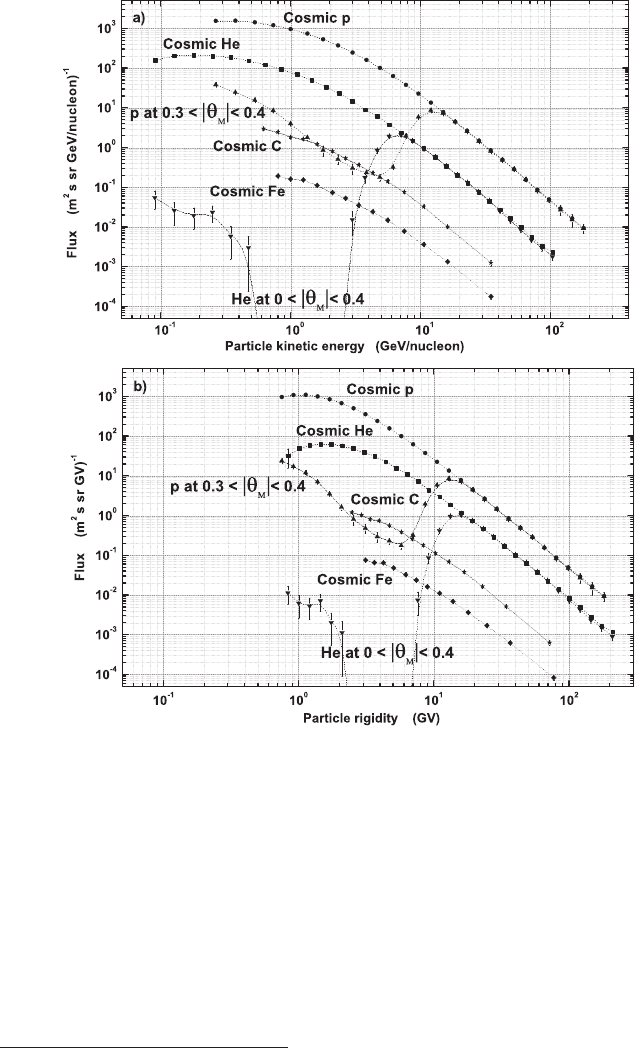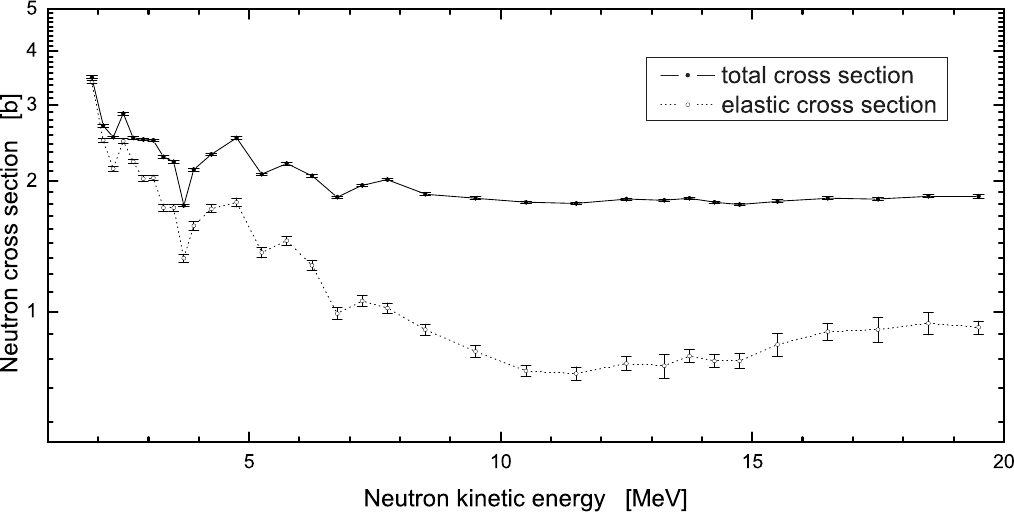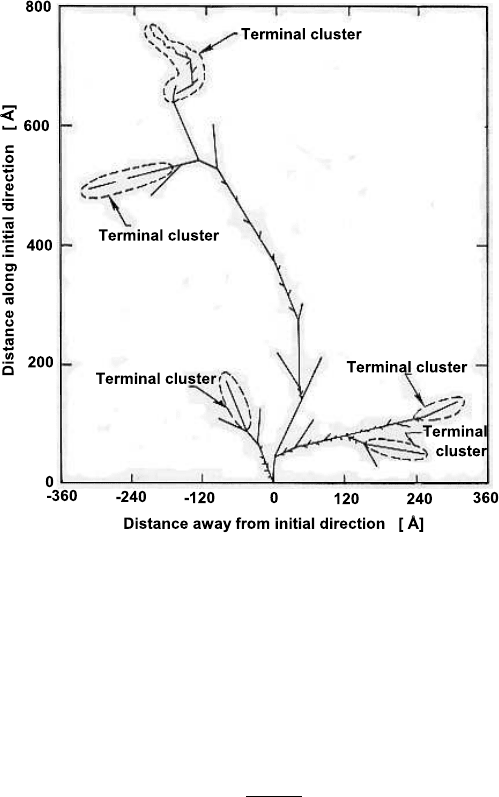Leroy C., Rancoita P.-G. Principles Of Radiation Interaction In Matter And Detection
Подождите немного. Документ загружается.


January 9, 2009 10:21 World Scientific Book - 9.75in x 6.5in ws-bo ok975x65˙n˙2nd˙Ed
340 Principles of Radiation Interaction in Matter and Detection
where R
p
H
is the proton rigidity at the same kinetic energy, i.e., E
k,p
= E
k
. In
addition, it can be remarked that for the stable
∗∗
and most abundant isotopes in
the heliosphere [i.e., up to nickel (Sect. 4.1.2.4)]
I
isot
Z
≈ 2.0–2.3.
As a consequence, less energetic (but heavier than proton) PCRs can penetrate
deeply the magnetosphere: in any location, the associated geomagnetic cut-off rigi-
dity, R
p
cut
, requires a kinetic energy of the isotope lower than that of a proton [see
Eq. (4.68)]. As discussed in [Bobik et al. (2006)], the rigidity (R
p
cut
) of geomagnetic
cut-off varies as a function of the observation location and increases with decreas-
ing the geomagnetic latitude: the PCRs with rigidities lower than the local value
of R
p
cut
cannot reach that observation region.
This effect is visible in Fig. 4.12(a), which, at the magnetosphere boundary (i.e.,
at 1 AU), shows the spectra (indicated as “cosmic”) of the i) proton and helium
differential energy distributions observed using the AMS-01 spectrometer and ii)
carbon and iron observed using the HEAO-3-C2 spectrometer (see also [Bobik et
al. (2006b); Boella et al. (2008)]). Figure 4.12(a) also shows the proton (helium)
spectrum observed with the AMS-01 spectrometer at the Shuttle altitude in the
geomagnetic region 0.3 ≤ |Θ
M
| ≤ 0.4 (0 ≤ |Θ
M
| ≤ 0.4). In Fig. 4.12(b), the same
spectra are shown as function of the particle rigidity expressed in GV. The AMS-
01 observations were carried out in June 1998 during the solar cycle 23; HEAO-3
observations from October 1979 up to June 1980, i.e., during the solar cycle 21. In
both periods the solar activity was rising from the minimum to the subsequent
maximum and the solar magnetic field polarity was positive. The angular acceptance
of the detectors, the altitude and the inclination of the orbits were such that the
observations were obtained under not too different experimental conditions. For
instance, for 0 ≤ |Θ
M
| ≤ 0.4 the geomagnetic cut-off rigidity is similar for protons
and helium particles [Fig. 4.12(b)], but it affects energetic protons more than helium
particles [e.g., see the cut-off effect shown in Fig. 4.12(a)].
At 1 AU and outside the Earth’s magnetosphere, the relative abundances to
protons for He (He/p), C (C/p) and Fe (Fe/p) nuclei can be calculated using the
“cosmic”-data (Fig. 4.12(a)); above 0.8 GeV/nucleon, the relative abundances
k
are
<
cos
He/p
≈ 0.067, <
cos
C/p
≈ 0.0019 and <
cos
fe/p
≈ 0.00018
for He/p, C/p and Fe/p, respectively [Gervasi and Grandi (2008)]. Furthermore
at an altitude of 400 km, the relative abundances inside the magnetosphere and
∗∗
For
3
H (tritium) and
3
He, this ratio is 3 and 1.5, respectively. Tritium has several different
experimentally-determined values of its half-life, the recommended value (e.g., see the web site:
http://nvl.nist.gov/pub/nistpubs/jres/105/4/j54luc2.pdf ) is 4500 ± 8 days (approximately 12.32
years). It decays into
3
He [Eq. (3.21)] by the reaction
3
H →
3
He + e
−
+ ¯ν
e
.
k
These values are affected by the solar modulation and may differ from those which are derived
using abundances at fixed values of kinetic energy per nucleon, large enough so that particles are
marginally modulated (e.g., see Fig. 4.11).

January 9, 2009 10:21 World Scientific Book - 9.75in x 6.5in ws-bo ok975x65˙n˙2nd˙Ed
Radiation Environments and Damage in Silicon Semiconductors 341
Fig. 4.12 Proton [AMS Collab. (2000a,d)], He [AMS Collab. (2000b)], C [Engelmann et al.
(1990)] and Fe [Engelmann et al. (1990)] fluxes as functions of (a) kinetic energy per nucleon
in GeV/nucleon and (b) particle rigidity in GV: p (•), He (¥), C (F) and Fe (¨) cosmic (i.e.,
these fluxes are observed well above the geomagnetic cut-off and can be considered at about 1
AU), p (N) in the geomagnetic region 0.3 ≤ |Θ
M
| ≤ 0.4 and He (H) in the geomagnetic region
0 ≤ |Θ
M
| ≤ 0.4 (from [Leroy and Rancoita (2007)]). At |Θ
M
| ≈ 0.4, R
p
cut
(the associated geomag-
netic cut-off proton rigidity) is ≈ 7–8 GV.
their ratios with those outside at 1 AU (i.e., the enhancement factors E
F
’s) were
computed using a transmission function (TF) approach (e.g., see [Boella et al.
(2008)] and discussion at page 342): for geomagnetic latitudes ranging from ≈ −46
◦
up to ≈ 46
◦
, the values of E
F
’s depend on the mass number I
isot
and are
∗
2.06 . E
F
. 3.74.
∗
See the discussion in Bobik, P. et al. (2009), Fluxes and Nuclear Abundances of Cosmic Rays in-
side the Magnetosphere using a TF Approach, J. Adv. Space Res., doi: 10.1016/j.asr.2008.11.020.
January 9, 2009 10:21 World Scientific Book - 9.75in x 6.5in ws-bo ok975x65˙n˙2nd˙Ed
342 Principles of Radiation Interaction in Matter and Detection
Thus, the resulting magnetospheric isotopic relative-abundances i) are modified be-
cause the proton component is more depleted than the other isotopic components
of GCR’s and ii) can depend on parameters like the geomagnetic latitude and/or
altitude.
It has to be noted that in Fig. 4.12 the proton (for 0.3 ≤ |Θ
M
| ≤ 0.4) and He (for
0 ≤ |Θ
M
| ≤ 0.4) spectra include both primary and secondary cosmic rays. These
latter are responsible for the flux increase below R
p
cut
. In addition, the same effect
is visible in the differential energy spectra for H, He and Fe for one solar cycle from
minimum to maximum reported in [Smart and Shea (1989); Gabriel (2000)].
As previously mentioned, in [Bobik et al. (2006)] the passage of the primary
protons through the magnetosphere to the AMS-01 spectrometer was treated using
the so-called transmission function [Adams et al. (1991); Boberg et al. (1995)],
which was determined by back-tracking the proton trajectories to determine those
allowed to primaries: the access of a primary proton to the observation location
is supposed to be allowed when the back-tracked particle trajectory reaches the
magnetopause. The TFs allowed one [Bobik et al. (2006)] to untangle the spec-
tra due to secondary protons from those observed, as function of the geomagne-
tic latitude, using the primary proton spectrum at 1 AU (the “cosmic”-protons in
Fig. 4.12). Some SCRs (mostly re-entrant albedo protons) were also found to pop-
ulate the rigidity regions above the local rigidity of geomagnetic cut-off [Bobik et
al. (2006)].
4.1.3 Neutron Spectral Fluence in Nuclear Reactor Environment
In the phenomenon of the neutron-induced nuclear fission, a nucleus captures a
neutron and breaks up into two nuclei (e.g., see Sections 5.2 and 5.5 in [Byrne
(1994)]). This process is accompanied by a large release of energy, typically about
200 MeV/fission, and the emission of one or more fast neutrons. A controlled self-
sustaining chain of fission reactions is called chain-reacting pile or nuclear reac-
tor. The first reactor was built by Fermi in 1942. The modern nuclear reactors are
basically machines that contain and control nuclear fission reactions, while pro-
ducing electricity. Besides power reactors, there are research reactors (like TRIGA
and Godiya types and others, see for instance [Kelly, Luera, Posey and Williams
(1988)], Chapter 5 in [Messenger and Ash (1992)] and [Angelescu et al. (1994)]),
which can provide sources of fission neutrons, for testing the performance of VLSI
transistors (and circuits) and detectors, and allow the simulation of nuclear environ-
ments (e.g., nuclear power reactors and weapons or high-luminosity colliding beam
accelerators).
The kinetic energies (E) of reactor fission neutrons do not exceed ≈
15 MeV. However, the available fission spectra differ for the energy distribution
of both thermal and fast neutrons (Table 4.2) and are characterized by a neutron

January 9, 2009 10:21 World Scientific Book - 9.75in x 6.5in ws-bo ok975x65˙n˙2nd˙Ed
Radiation Environments and Damage in Silicon Semiconductors 343
spectral-fluence φ(E) in n/(cm
2
MeV) obtained as
φ(E) =
Z
ψ(E, t) dt, (4.77)
where ψ(E, t) is the neutron spectral-flux in n/(s cm
2
MeV), and by a neutron fluence
Φ
n
=
Z
E
min
φ(E) dE [n/cm
2
], (4.78)
where E
min
is the minimum neutron kinetic-energy (typically about 10 keV) to
induce radiation damage by atomic displacements (see for instance Section 5.9
in [Messenger and Ash (1992)]). Thus, Φ
n
accounts for the neutron fluence
‡‡
re-
lated to radiation-induced damages, i.e., above 10 keV in n–silicon interactions, the
energy released for displacement damages is no longer negligible (see Sect. 4.2.1).
The displacement damages induced by neutrons can be normalized to displa-
cement damages induced by 1 MeV neutrons by means of the hardness parameter
(κ) also termed hardness factor (see Sect. 4.2.1 and, for a further discussion, see
for instance [Namenson, Wolicki and Messenger (1982); Kelly, Luera, Posey and
Williams (1988); Vasilescu (1997)]). For fission neutrons with spectral fluence φ(E),
the 1 MeV equivalent neutron fluence is given by:
Φ
1 MeV
eq
= κ
Z
E
min
φ(E) dE = κ Φ
n
. (4.79)
Φ
1 MeV
eq
is the fluence of 1 MeV neutron needed for generating the same amount of
displacement damage compared to the fission fluence Φ
n
(see, also, footnote at page
291).
4.1.3.1 Fast Neutron Cross Section on Silicon
Neutron interactions on nuclei were widely studied and their cross sections deter-
mined exp erimentally: these latter are, for instance, available on the web at the
IAEA
k
- Nuclear Data Service (2007).
In addition, nowadays, for the scattering of a fast neutron on
28
Si a systematic
evaluation of all important cross sections is reported in [Tagesen, Vonach and Wall-
ner (2002)]: it covers the neutron energy-range (1.75–20) MeV, i.e., for an energy
range well above the resonance region (Sect. 4.1.3.2) and of interest for reactions
resulting in displacement damage. The evaluation uses experimental data compiled
in EXFOR (e.g., see [IAEA - Nuclear Data Service (2007)]) supplemented by very
recent ones: the total and elastic cross sections are shown in Fig. 4.13. The elastic
cross section was obtained as the difference between the total and non-elastic cross
sections. This latter was derived summing the inelastic cross sections and those for
reactions like, for example, (n,2n), (n,p), (n,α), (n,d). . . (for a complete discussion
see [Tagesen, Vonach and Wallner (2002)] ).
‡‡
The total neutron fluence can be computed with E
min
= 0.
k
IAEA is the International Atomic Energy Agency located in Vienna (Austria).

January 9, 2009 10:21 World Scientific Book - 9.75in x 6.5in ws-bo ok975x65˙n˙2nd˙Ed
344 Principles of Radiation Interaction in Matter and Detection
Fig. 4.13 Total and elastic (see text) cross sections (in barn) for neutrons on
28
Si with kinetic energies of (1.75–20) MeV. The lines are to guide the
eye. Data were obtained from [Tagesen, Vonach and Wallner (2002)].

January 9, 2009 10:21 World Scientific Book - 9.75in x 6.5in ws-bo ok975x65˙n˙2nd˙Ed
Radiation Environments and Damage in Silicon Semiconductors 345
Table 4.2 Classification of neutrons as a function of kinetic energy.
Energy Classification and Subdivision Subdivision energy-range
E
n
(eV) E
n
(eV)
0 < E
n
< 1 Slow
Ultra cold
Very cold
Cold
Thermal
Epithermal
E
n
< 2 × 10
−7
2 × 10
−7
≤ E
n
< 5 × 10
−5
5 × 10
−5
≤ E
n
. 0.025
E
n
' 0.025
0.025 . E
n
≤ 1
1 < E
n
< 10
6
Intermediate
including
Resonance 1 < E
n
< 100
10
6
< E
n
< 10
7
Fast
(1)
10
7
< E
n
< 5 × 10
7
Very fast
5 × 10
7
< E
n
< 10
10
Ultra fast
> 10
10
Relativistic
(1)
: in Section 1.5.5.3 of [Byrne (1994)], a neutron with kinetic energy > 1 MeV is termed fast; in
Section 12.2.2 of [Marmier and Sheldon (1970)], a neutron is considered fast for 0.5 < E
n
< 10 MeV.
4.1.3.2 Energy Distribution of Reactor Neutrons and Classification
As mentioned in the previous section, reactor-neutron production is one of the most
widely used methods of obtaining fast neutrons. The spectral fluence of emerging
almost-thermal and fast neutrons depends on the type of reactor and moderator
(e.g., see Chapter 12 of [Marmier and Sheldon (1970)], [Kelly, Luera, Posey and
Williams (1988)], Chapter 5 in [Messenger and Ash (1992)], Chapter 1 of [Byrne
(1994)] and [Angelescu et al. (1994)]). The spectral fluence largely decreases with
increasing energy and, usually, it has a high-energy tail which extends up to energies
above 10–15 MeV.
Neutrons are classified as a function of their kinetic energy. However, the clas-
sification has slightly varied with time. Commonly used terms, their subdivisions
and kinetic energy ranges are shown in Table 4.2, following the classification i) for
slow (≤ 1 eV), intermediate (1 eV–1 MeV) and fast (> 1 MeV) neutrons from Sec-
tion 1.5.5.3 of [Byrne (1994)] and ii) above 10 MeV from Section 12.2.2 of [Marmier
and Sheldon (1970)]. The energy of 1 eV
¶
is chosen to define the energy below
which a neutron is termed slow. By convention, a thermal neutron is taken to have
an energy of 0.025 eV. This energy is the mean energy of a neutron at thermal
equilibrium with its surrounding at 20
◦
C; it corresponds to a neutron velocity of
' 2.2 km/s and a neutron wavelength of ' 1.8
˚
A.
In silicon, displacement damage is mostly induced by fast, very fast, ultra fast
¶
It is the typical energy of the lowest resonance in the reactor moderating material (e.g., see
Section 1.5.5.3 of [Byrne (1994)]).

January 9, 2009 10:21 World Scientific Book - 9.75in x 6.5in ws-bo ok975x65˙n˙2nd˙Ed
346 Principles of Radiation Interaction in Matter and Detection
and relativistic neutrons (see Sects. 4.2.1, 4.2.1.2 and 4.2.1.5). In this book, the
term fast neutron is commonly used for a neutron i) with kinetic energy lower than
that corresponding to the ultra fast region and ii) capable to induce a relevant
displacement damage (e.g., see Figs. 4.18 and 4.19), thus, typically with kinetic
energies & 10 keV (e.g., see Sects. 4.1.3 and 4.2.1). Furthermore, it has to be noted
that the damage induced by a 1 MeV neutron is taken as ASTM-standard reference
[ASTM (1985)] (see Sect. 4.2.1).
4.2 Relevant Processes of Energy Deposition and Damage
Particles and photons passing through matter lose energy (or can be absorbed) by
means of a variety of interactions and scattering processes, which result in two major
effects: the collision energy-loss and atomic displacement. Interactions
§
of incoming
particles which result in the excitation or emission of atomic electrons (i.e. ionizing
the atom) are referred to as energy-loss by ionization or energy-loss by collisions
(see Sect. 4.2.3). The non-ionization energy-loss (NIEL) processes are interactions in
which the energy imparted by the incoming particle results in atomic displacements
or in collisions where the knock-on atom does not move from its lattice location and
the energy is dissipated in lattice vibrations (phonons), for instance.
The energy deposition by non-ionization processes is much lower (except for
neutrons) than that by ionization. However, bulk damage mechanisms result mostly
from atomic displacements (the so-called displacement damages).
Although the mechanisms of induced damage are somewhat similar in semicon-
ductors and in semiconductor components, we restrict this treatment to what is
relevant for silicon radiation-detectors and devices.
4.2.1 NIEL and Displacement Damage
Displacements occur when the primary interaction results in the displacement of
the recoil atom from its lattice position. The knock-on atoms (PKAs) primarily
create Frenkel defects (called also Frenkel-pairs; see, for instance, [James and Lark-
Horovitz (1951); Kraner (1982)]). A Frenkel defect, which differs from dislocations
and more complex imp erfections, is a pair of point defects (i.e., highly localized
imperfections arising in a crystal from a one-atom disorder) close enough to exhibit
an interaction: a vacancy (V ) and an atom in interstitial position (I).
For collisions hard enough to allow large energy transfers, the PKA can collide
with other lattice atoms, creating more vacancies and interstitial atoms. At thermal
equilibrium, the recoil atoms will be located in interstitial positions, unless some
of them recombine with vacancies: some of these point defects are isolated, but for
§
These interactions in matter are reviewed in the chapter on Electromagnetic Interaction of
Radiation in Matter with an extensive treatment of collision energy-losses in silicon media (see,
also, Chapter 2 in [Leroy and Rancoita (2004)]).

January 9, 2009 10:21 World Scientific Book - 9.75in x 6.5in ws-bo ok975x65˙n˙2nd˙Ed
Radiation Environments and Damage in Silicon Semiconductors 347
recoil energies much larger than the displacement threshold energy, E
d
, cascading
displacements will occur in a closely spaced group of defects (the so-called cluster
or cluster of defects, e.g., see Sect. 4.2.2) within a small spatial region (or even a
few small spatial regions). Figure 4.14 shows an example of simulated cascading-
displacements by a silicon recoil in bulk silicon after the interaction with an incoming
neutron of 50 keV kinetic energy (from [van Lint, Leadon and Colweel (1972)]; see
also Chapter 2 of [van Lint, Flanahan, Leadon, Naber and Rogers (1980)]): a
few energetic collisions produce other energetic recoils interspaced with many more
low-energy transfers. Thus, cascading displacements result in (terminal) clusters of
defects.
The thermal energy allows some defects to migrate through the crystal and,
eventually, be annihilated by the recombination of the V –I pairs or create stable
defects in association with other impurities or defects already present (or induced
by radiation). The presence of defects and clusters of defects produces changes in
the properties of the semiconductor.
In radiation-induced defects, E
d
is several times greater than the energy re-
quired for adiabatic displacements of atoms from lattice to interstitial positions. E
d
depends on the recoil direction and, for silicon, is about (13–33) eV (e.g., see Chap-
ter 1 in [Vavilov and Ukhin (1977)], [Chilingarov, Lipka, Meyer and Sloan (2000)]
and references therein). In most of calculations, in particular for incoming neutrons
(see Sect. 4.2.1.5), an isotropic value of 25 eV is assumed (e.g., see page 24 of [Di-
enes and Vineyard (1957)], Section 2.4.2 in [van Lint, Flanahan, Leadon, Naber and
Rogers (1980)] and references therein, see also Section V of [Nichols and van Lint
(1966)]).
There has b een substantial progress in understanding the degradation generated
in integrated bipolar transistors
§
and silicon detectors
¶
by fast neutrons, i.e., typ-
ically above 10 keV, which induce displacement damages. Neutrons with sufficient
large energies, like for instance fast neutrons, can transfer enough kinetic energy to
the recoil atom to generate clusters of displacements with a cascading effect.
Most predictions of the neutron energy dependence in semiconductor (i.e. sili-
con) devices have been based on the amount of non-ionizing energy deposited. In
literature (see for instance [Namenson, Wolicki and Messenger (1982); Ougouag,
Williams, Danjaji, Yang and Meason (1990); Vasilescu (1997)]), the damage effect
due to initial and cascading-displacements induced by neutrons (Sect. 4.2.1.2) is
§
The reader can see, e.g., [Messenger (1966, 1972, 1992); Colder et al. (2001); Claeys and Simoen
(2002); Holmes-Siedle and Adams (2002); Co degoni et al. (2004b); Consolandi, D’Angelo, Fallica,
Mangoni, Modica, Pensotti and Rancoita (2006)] and references therein.
¶
One can see, e.g., [Borgeaud, McEwen, Rancoita and Seidman (1983); SICAPO Collab. (1986,
1994b,c, 1995c); Croitoru, Dahan, Rancoita, Rattaggi, Rossi and Seidman (1997); Croitoru, Ran-
coita, Rattaggi, Rossi and Seidman (1997); Dezillie, Bates, Glaser, Lemeilleur and Leroy (1997);
Borchi, Bruzzi, Leroy, Pirollo and Sciortino (1998); Croitoru, David, Rancoita, Rattaggi and Sei-
dman (1998a); Croitoru, Gubbini, Rancoita, Rattaggi and Seidman (1999a); Leroy, Roy, Casse,
Glaser, Grigoriev and Lemeilleur (1999a); Mangiagalli, Levalois, Marie, Rancoita and Rattaggi
(1999); Golan et al. (2001); Rose Collab. (2001)] and references therein.

January 9, 2009 10:21 World Scientific Book - 9.75in x 6.5in ws-bo ok975x65˙n˙2nd˙Ed
348 Principles of Radiation Interaction in Matter and Detection
expressed by the damage function (also referred to as displacement kerma func-
tion) D(E) in units of MeV cm
2
, whose value at 1 MeV is the ASTM standard
D(1 MeV) = 95 MeV mb [ASTM (1985)]. The damage function
∗∗
, which accounts
for both the cross section for neutron–silicon scattering and the energy released in
creating displacements, is given by [Codegoni et al. (2004b); Consolandi, D’Angelo,
Fallica, Mangoni, Modica, Pensotti and Rancoita (2006)]:
D(E) =
X
k
σ
k
(E)
Z
f
k
(E, E
R
)P
k
(E
R
) dE
R
, (4.80)
where E is the incoming neutron kinetic-energy, σ
k
(E) is the cross section for the
k-th reaction, f
k
(E, E
R
) dE
R
is the probability that a recoil atom is generated with
kinetic energy between E
R
and E
R
+ dE
R
, and, finally, P
k
(E
R
) is the partition
energy for the recoil nucleus. This latter is the part of the recoil energy deposited
in displacements, calculated in the framework of the Lindhard screened-potential
scattering theory [Lindhard, Nielsen, Scharff and Thomsen (1963)], based on the
Thomas–Fermi model and further developments [Parkin and Coulter (1977, 1979);
Coulter and Parkin (1980)], or, for instance, by means of Robinson’s analytical
approximation [Robinson (1970)] (e.g., for elastic neutron–silicon interactions see
Eq. (4.90) for silicon recoil in a silicon medium). The damage function for neutron
is reviewed in Sect. 4.2.1.5.
From Equation (4.80), the energy density, E
dis
, deposited through atomic
displacements by neutrons characterized by a neutron spectral-fluence φ(E) in
n cm
−2
MeV
−1
(Sect. 4.1.3), is the damage energy, E
de
, (i.e., the defect producing
energy) imparted per cm
3
and is given by:
E
dis
= n
Si
Z
E
min
D(E) φ(E) dE [MeV/cm
3
], (4.81)
where [see page 14 and Eq. (1.39)]
n
Si
=
ρ
Si
N
A
Si
(4.82)
is the number of atoms per cm
3
in the bulk silicon, ρ
Si
and A
Si
are the density and
atomic weight of the silicon medium, respectively; N is the Avogadro constant (see
Appendix A.2) and E
min
is the minimum neutron energy for inducing displacement
damage. Since the damage function for soft and thermal neutron is much lower
than that for fast neutrons (Sect. 4.2.1.5), for spectral fluences of reactor neutrons
the integral in Eq. (4.81), thus the value of E
dis
, marginally depends on E
min
up
to about 10 keV. For example, in the case of the neutron spectrum of the Triga
reactor RC:1 at Casaccia (Rome) the value of E
dis
varies by no more than 0.5% for
E
min
≤ 10 keV [Codegoni et al. (2004b); Consolandi, D’Angelo, Fallica, Mangoni,
Modica, Pensotti and Rancoita (2006)].
∗∗
See, for instance, [Ougouag, Williams, Danjaji, Yang and Meason (1990)] and Chapter 5 in
[Messenger and Ash (1992)].

January 9, 2009 10:21 World Scientific Book - 9.75in x 6.5in ws-bo ok975x65˙n˙2nd˙Ed
Radiation Environments and Damage in Silicon Semiconductors 349
Fig. 4.14 Simulation of cascading-displacements generated by a silicon recoil in bulk silicon after
the interaction with an incoming neutron of 50 keV kinetic energy (adapted and reprinted with
permission from van Lint, V.A.J., Leadon, R.E., and Colwell, J.F., Energy Dependence of Di-
splacement Effects in Semiconductors, IEEE Transactions on Nuclear Science, Volume 19, Issue
6, Dec. 1972, pages 181–185, doi: 10.1109/TNS.1972.4326830,
c
° 1972 IEEE; see also Chapter 2
of [van Lint, Flanahan, Leadon, Naber and Rogers (1980)]). The distances are in
˚
A.
The concentration of Frenkel-pairs (FP ), i.e., the number of Frenkel defects per
cm
3
, can be computed by means of the modified Kinchin–Pease formula [Eq. (4.89),
see also discussion in Sect. 4.2.1.1] and Eq. (4.81) as:
FP ∼
E
dis
2.5 E
d
. (4.83)
For the case of the Triga neutron spectrum Eq. (4.83) yields a Frenkel-pairs concen-
tration of about 43.3 per incoming neutron per cm
2
with energy above 10 keV. This
value also accounts for the low energy part of the neutron spectrum, i.e., below
10 keV, which contributes by no more than 0.5% to the FP overall value.
From Eqs. (4.79, 4.81), we can derive the hardness parameter κ as:
n
Si
D(1 MeV) Φ
1 MeV
eq
= κ n
Si
D(1 MeV)
Z
E
min
φ(E) dE
= n
Si
Z
E
min
D(E) φ(E) dE,
